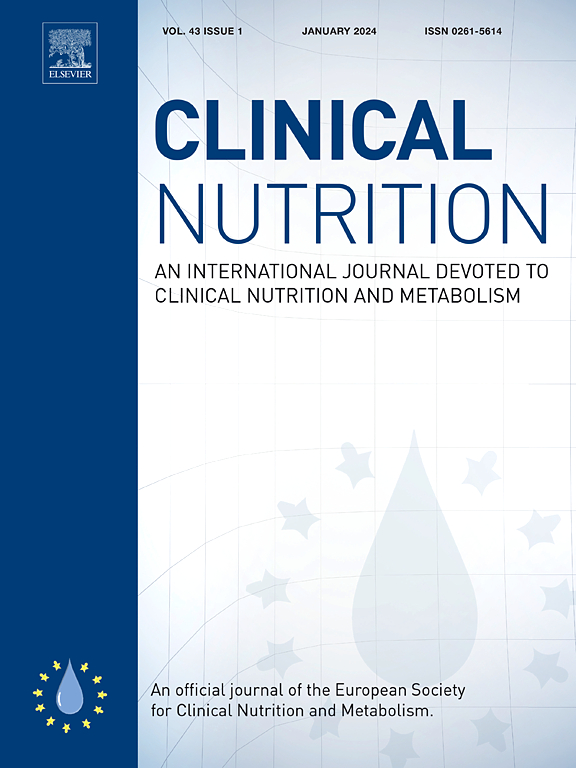Osteosarcopenic obesity: A systematic review and a call for consensus on definitions and diagnostic criteria
IF 7.4
2区 医学
Q1 NUTRITION & DIETETICS
引用次数: 0
Abstract
Background & aim
Osteosarcopenic obesity (OSO) is a clinical and functional condition characterized by the coexistence of osteopenia/osteoporosis, sarcopenia, and obesity (excess adiposity). Currently, the lack of consensus on diagnostic criteria and cut-off values complicates prevalence estimates and limits its potential role as a predictor for various diseases. This systematic review aimed at examining current definitions and diagnostic criteria adopted in individuals with OSO.
Methods
A systematic search was conducted on PubMed, Scopus and Web of Science from inception until July 31st, 2024. Human studies involving all ages, sexes, and ethnicities were included, excluding those lacking well-specified definitions or cut-offs for osteopenia/osteoporosis, sarcopenia and obesity. Results were reported in accordance with the PRISMA 2020 guidelines, with methodological quality assessed using the Quality Assessment Tools of the National Institutes of Health.
Results
After removing duplicates and screening titles and abstracts, 64 potentially eligible studies were examined. Of these, 39 studies involving 118,791 participants met the inclusion criteria. Significant heterogeneity was observed in the diagnostic approaches, largely due to the variability in parameters and methods used to assess sarcopenia and obesity, and reference cut-offs. This may partly be explained by differences in the availability of body composition techniques across settings, investigators’ level of expertise and the study population involved.
Conclusion
These findings underscore the need for consensus guidelines that provide a standardized definition of OSO, diagnostic criteria with practical and clinically relevant cut-offs, and consistent methodologies. This will help identify the prevalence of OSO, define its clinical and functional significance, and develop effective prevention and treatment strategies.
骨质疏松性肥胖:一项系统综述,并呼吁就定义和诊断标准达成共识
背景,目的mosteosarcopenic obesity (OSO)是一种以骨质减少/骨质疏松、肌肉减少和肥胖(过度肥胖)共存为特征的临床和功能疾病。目前,对诊断标准和临界值缺乏共识使患病率估计复杂化,并限制了其作为各种疾病预测因子的潜在作用。本系统综述旨在检查OSO患者目前采用的定义和诊断标准。方法系统检索PubMed、Scopus和Web of Science自建站至2024年7月31日的文献。纳入了所有年龄、性别和种族的人类研究,排除了那些缺乏骨质减少/骨质疏松症、肌肉减少症和肥胖的明确定义或临界值的研究。根据PRISMA 2020指南报告了结果,并使用美国国立卫生研究院的质量评估工具对方法质量进行了评估。结果在删除重复、筛选标题和摘要后,我们检查了64项可能符合条件的研究。其中,39项涉及118,791名参与者的研究符合纳入标准。在诊断方法中观察到显著的异质性,主要是由于用于评估肌肉减少症和肥胖的参数和方法以及参考截止值的可变性。这在一定程度上可以解释为身体成分技术在不同环境下的可用性、调查者的专业水平和所涉及的研究人群的差异。结论:这些发现强调了对OSO的标准化定义、具有实际和临床相关界限的诊断标准以及一致的方法的共识指南的必要性。这将有助于确定OSO的患病率,确定其临床和功能意义,并制定有效的预防和治疗策略。
本文章由计算机程序翻译,如有差异,请以英文原文为准。
求助全文
约1分钟内获得全文
求助全文
来源期刊

Clinical nutrition
医学-营养学
CiteScore
14.10
自引率
6.30%
发文量
356
审稿时长
28 days
期刊介绍:
Clinical Nutrition, the official journal of ESPEN, The European Society for Clinical Nutrition and Metabolism, is an international journal providing essential scientific information on nutritional and metabolic care and the relationship between nutrition and disease both in the setting of basic science and clinical practice. Published bi-monthly, each issue combines original articles and reviews providing an invaluable reference for any specialist concerned with these fields.
 求助内容:
求助内容: 应助结果提醒方式:
应助结果提醒方式:


